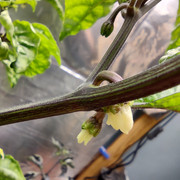The other day I watched a single bee in my garden go from a Piquin to a Tabasco, to a Borg-9, to a habanero and continue for a few more plants before I lost track of it.
At each of these plants it visited 1-3 flowers.
Bees have been observed in the garden at nearly all times of day when the sun is out and often dozens are visible working at a time.
I have noticed other pollinators like various flies and even thrips, as well as bumblebees. I have raspberries in a large patch next to my pepper patch and the raspberries attract a lot of bees.
Last year I had raspberries as well, naturally, but I had only two Habanero plants in the yard and observed very little pollination and one of the plants had very low fruit set. This year nothing has low fruit set.
I have about 40-50 Capsicum plants and bees frequent the plants daily. I expect that the rate of outcrossing from pollen transfer is very high among the plants at present, particularly for those plants with a stigma or style that extends past the anthers of the flowers.
My observation is that as the # of plants increases so does the chance that pollinators will take specific notice of them. Last year I didn't have bees looking for and specifically visiting Capsicum flowers but this year there are many.
This is desirable for me as that I am not fond of inbred things.
At each of these plants it visited 1-3 flowers.
Bees have been observed in the garden at nearly all times of day when the sun is out and often dozens are visible working at a time.
I have noticed other pollinators like various flies and even thrips, as well as bumblebees. I have raspberries in a large patch next to my pepper patch and the raspberries attract a lot of bees.
Last year I had raspberries as well, naturally, but I had only two Habanero plants in the yard and observed very little pollination and one of the plants had very low fruit set. This year nothing has low fruit set.
I have about 40-50 Capsicum plants and bees frequent the plants daily. I expect that the rate of outcrossing from pollen transfer is very high among the plants at present, particularly for those plants with a stigma or style that extends past the anthers of the flowers.
My observation is that as the # of plants increases so does the chance that pollinators will take specific notice of them. Last year I didn't have bees looking for and specifically visiting Capsicum flowers but this year there are many.
This is desirable for me as that I am not fond of inbred things.






